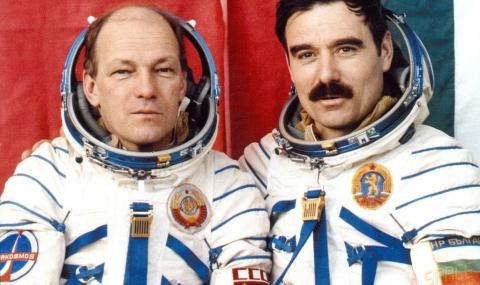On April 10, 1979 at 8:34 p.m. a spacecraft was launched with the first Bulgarian cosmonaut Georgi Ivanov
In 1979 at 8:34 p.m. Moscow time, the spacecraft “Soyuz 33” was launched into space, carrying the first Bulgarian cosmonaut Georgi Ivanov. The commander of the flight was Nikolai Rukavishnikov.
The main goal is to dock with the “Salyut 6” station, where Vladimir Lyakhov and Valery Ryumin are located. After that, it is planned to carry out 28 scientific experiments, including the entirely Bulgarian systems and instruments “Spektar 15”, “Sredets” and “Pirin”. According to the plan, the crew should exchange their capsule with the “Soyuz 32” capsule attached to the station and land with it.
After the successful launch from Baikonur at 20:34 (Moscow time), the ship spent the first 24 hours as planned in fine-tuning its orbit and preparing for rapprochement and docking with the “Salyut 6” station.
Due to a technical malfunction, the ship failed to dock with the “Salyut 6” orbital station. After approaching 3 km and establishing visual contact, the main engine of the “Soyuz 33” ship suddenly failed. It was supposed to work for 6 seconds, but it turned itself off after the first 3 seconds, and the crew on the Salyut 6 station, who was observing the docking attempt, saw a spark from the main engine in the direction of the backup engine at the moment of the unexpected shutdown. The Igla system also failed. The next three attempts to start the main engine were unsuccessful.
The crews spent 12 hours resting while they decided on further actions from the ground. As expected, the docking was canceled so as not to damage the space station in any way. The crew of Soyuz 33 began preparing to return to Earth.
The ship's chief designer, Yuri Simeonov, decided not to do a three-second test of the backup engine, but to turn it on directly and proceed with the landing. The backup engine fired, but did not shut down after 188 seconds, as expected. Commander Rukavishnikov waited the maximum allowable additional time of 25 seconds, then manually stopped the engine. As a result of the excessive impulse, the capsule entered the atmosphere on a ballistic curve at a very sharp angle.
When reaching the denser air layers, the acceleration increased to 10G (98 m/s²) for over two minutes. The cosmonauts were able to withstand this acceleration thanks to the severe ground training during their preparation. When they landed, they were 320 km southeast of Dzhezkazgan. They had made 31 complete orbits of the Earth. They spent 1 day, 23 hours and 1 minute in space.
The cause of the accident remains unknown, as the module with the engines separated from the capsule upon entering the atmosphere, recalls blogger Dani Ivanov.
The scientific experiments that failed to be carried out by “Soyuz 33” were subsequently successfully carried out on the station by Lyakhov and Ryumin. The results were also transmitted to specialists from the Bulgarian Academy of Sciences. Today, the descent device of the “Soyuz 33” spacecraft is stored in the Aviation Museum near Plovdiv.
